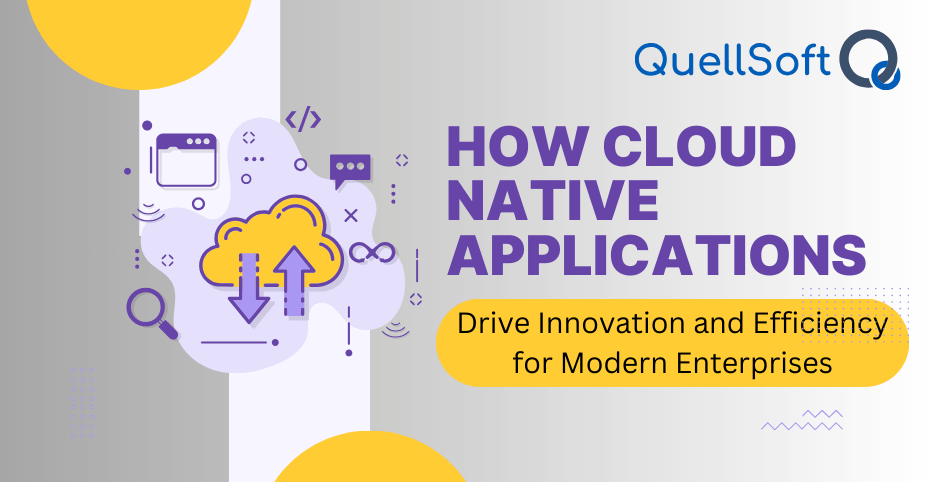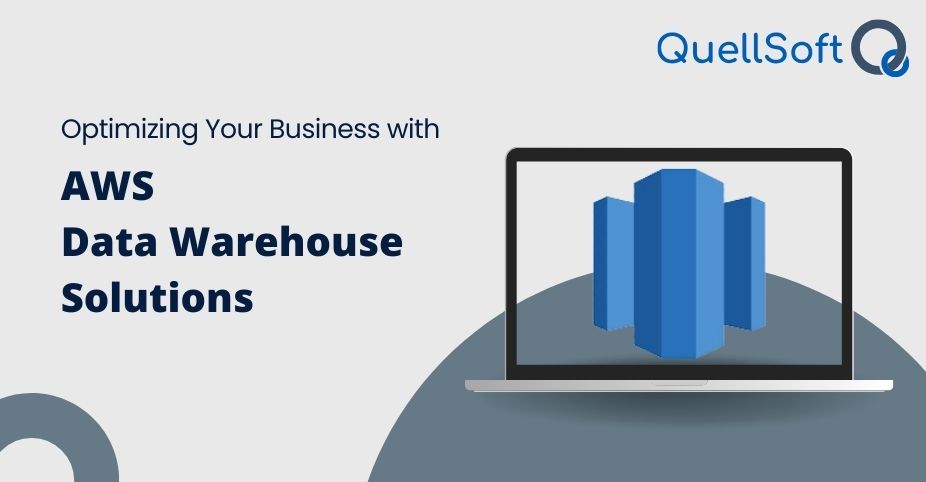
How Cloud Native Applications Drive Innovation and Efficiency for Modern Enterprises
In today’s rapidly evolving digital landscape, modern enterprises are constantly seeking ways to enhance their efficiency and fuel innovation. One of the most transformative developments in this area is the rise of cloud native applications. Quellsoft, a leading provider of cloud native solutions, helps businesses operate with greater agility, scalability, and cost efficiency.
Cities like New York and New Jersey are at the forefront of this revolution, with industries ranging from finance to healthcare adopting cloud native app development to stay competitive in a technology-driven world. By utilizing cloud-native technologies, businesses in these regions are not only driving innovation but also optimizing their processes for the future.
What Are Cloud Native Applications?
Definition of Cloud Native Applications
Cloud native applications are software programs that are specifically designed to run in cloud environments. Unlike traditional applications, which are often developed for on-premise systems and then migrated to the cloud, cloud-native applications are built from the ground up to leverage the full capabilities of cloud platforms.
These applications use a combination of modern development techniques, such as microservices, containers, and dynamic orchestration, to ensure they are highly scalable, flexible, and resilient. This makes them ideal for enterprises looking to accelerate their digital transformation. For example, companies in Manhattan’s Financial District are using cloud native architectures to quickly deploy new features and improve their overall service delivery.
Key Characteristics of Cloud Native Applications
Some defining characteristics of cloud native applications include:
- Microservices Architecture: Applications are broken down into small, independent services that can be developed, deployed, and scaled individually.
- Containers: Each microservice is packaged into a container (e.g., Docker), ensuring consistency and portability across environments.
- CI/CD Pipelines: Continuous integration and continuous deployment (CI/CD) allow for frequent updates and rapid delivery of new features, which is especially useful for enterprises in tech hubs like Jersey City.
- Orchestration: Tools like Kubernetes manage containers dynamically, ensuring optimal resource allocation and scaling.
By building applications with these principles, businesses can enhance their ability to innovate and stay agile in competitive markets like New York and New Jersey.
Importance for Modern Enterprises
The shift toward cloud native applications is crucial for enterprises aiming to stay competitive in today’s fast-paced digital economy. By designing applications specifically for the cloud, businesses can:
- Accelerate Innovation: Cloud native apps allow enterprises to bring new features and services to market faster than ever before.
- Improve Operational Efficiency: With cloud-native architecture, businesses can reduce downtime, improve resource utilization, and scale more efficiently.
- Enhance Customer Experiences: By ensuring apps are always available and performant, businesses can offer better services to customers, especially in busy urban centers like Brooklyn and Hoboken.
Key Benefits of Cloud Native Applications for Enterprises
Increased Agility and Speed to Market
One of the most significant advantages of cloud native applications is their ability to enhance agility and speed to market. Since these applications are built using modular microservices, teams can develop and deploy updates independently, without affecting the entire system. This allows businesses to quickly roll out new features or fixes in response to market demands.
For example, startups in Silicon Alley (New York’s tech hub) can use cloud native app development to innovate at a rapid pace, staying ahead of the competition by delivering faster and more efficient solutions.
Scalability and Flexibility
Scalability is another critical benefit of cloud native applications. Because these applications are hosted on cloud platforms, they can easily scale up or down based on demand. Enterprises can allocate resources dynamically, ensuring that they only pay for what they need, reducing overall costs.
For businesses in New Jersey, this flexibility is especially valuable. Retailers, for instance, can scale up their resources during high-traffic seasons like Black Friday or holiday sales, and scale them back down afterward. This ability to handle fluctuating workloads ensures better performance and cost efficiency.
Improved Efficiency and Automation
Automation is a key feature of cloud native applications, driving efficiency across the board. These applications use tools like automated testing, continuous integration, and self-healing systems to optimize performance without requiring manual intervention.
In sectors such as healthcare in New York, cloud-native architecture allows for improved efficiency by reducing manual workloads and ensuring high availability of critical applications.
Cost Efficiency
In addition to improving operational efficiency, cloud native applications also help businesses lower costs. By utilizing cloud infrastructure, enterprises can reduce capital expenditures (CapEx) on hardware, instead opting for an operational expenditure (OpEx) model.
This shift allows small businesses in Brooklyn to allocate their resources more effectively, investing in innovation rather than maintaining expensive IT infrastructure.
Resilience and Reliability
Finally, cloud native applications offer unparalleled resilience. Built with redundancy and failover mechanisms, these apps ensure high availability and minimal downtime, even during disasters or hardware failures.
This is particularly important for industries like finance, where reliability is critical. Banks and financial services in New York’s Financial District benefit from cloud-native architectures, ensuring that their services remain operational even in times of high demand or unexpected outages.
Cloud Native Application Development
Overview of Cloud Native App Development
Cloud native app development is the process of designing, building, and deploying applications that are specifically optimized for cloud environments. Unlike traditional software development, which often involves adapting on-premise systems to the cloud, cloud-native development focuses on maximizing the benefits of cloud computing from the very beginning.
The adoption of cloud native applications is growing across industries due to their ability to support agility, scalability, and rapid iteration. For businesses in areas like New York and New Jersey, where speed and flexibility are critical, cloud-native development provides a significant competitive advantage.
Pillars of Cloud Native Application Architecture
To fully understand cloud native app development, it’s essential to recognize the foundational pillars of the architecture. These include:
- Containers: These are lightweight, standalone packages that include everything needed to run a specific application or service, ensuring consistency across different environments.
- Microservices: Applications are broken down into small, independent services that can be developed, deployed, and managed separately.
- Dynamic Orchestration: Tools like Kubernetes manage containers and ensure that they run efficiently, allocating resources dynamically based on demand.
- CI/CD Pipelines: Continuous integration and continuous deployment allow for rapid and frequent updates, making it easier for businesses to innovate and respond to market changes.
These pillars make cloud native applications highly adaptable and scalable, which is particularly valuable for tech-focused enterprises in regions like Hoboken and Newark, where businesses must constantly evolve to stay competitive.
Cloud Native App Development in Practice
In practice, cloud native app development enables businesses to continuously improve their software, deploy updates with minimal downtime, and scale services to meet fluctuating demand. For example, many companies in New York’s Silicon Alley are leveraging cloud-native principles to deploy new features and updates daily, ensuring they remain at the cutting edge of innovation.
Moreover, cloud native android app development is becoming increasingly important as mobile applications grow in popularity. Android apps built using cloud-native principles benefit from the same flexibility, scalability, and automation, making them ideal for enterprises targeting users in fast-moving markets like Queens or Jersey City.
Cloud Native Android App Development
What Is Cloud Native Android App Development?
Cloud native android app development refers to the process of building Android applications that are designed to take full advantage of cloud environments. Like their web-based counterparts, these apps are developed using cloud-native principles such as microservices, containers, and CI/CD pipelines.
This approach allows Android apps to be highly scalable, resilient, and responsive, which is essential for businesses in high-demand markets such as New York. By building mobile apps with cloud-native architecture, businesses can ensure that their applications can handle millions of users while maintaining a seamless user experience.
Benefits of Cloud Native Android App Development
Cloud native android app development offers several advantages for enterprises:
- Scalability: Cloud-native Android apps can easily scale up or down based on the number of users, ensuring optimal performance at all times.
- Automatic Updates: Because of the continuous deployment processes, Android apps can be updated frequently without requiring users to download new versions manually. This is particularly useful for startups in Jersey City that need to roll out improvements and new features quickly.
- Performance Optimization: With cloud-native architecture, Android apps can dynamically allocate resources, ensuring that they run efficiently even during periods of high traffic.
Use Cases in New York and New Jersey
Several businesses in New York and New Jersey are adopting cloud native android app development to stay ahead of their competitors. For example, retail and e-commerce companies in Brooklyn are using cloud-native mobile apps to offer personalized experiences to millions of customers, while healthcare startups in Newark are building secure, scalable Android apps to streamline patient management and deliver telehealth services.
These use cases illustrate how cloud-native principles can revolutionize Android app development, enabling enterprises to deliver high-quality mobile experiences with minimal downtime and maximum scalability.
How Cloud Native Applications Drive Innovation
Innovation Through Microservices
One of the key ways that cloud native applications drive innovation is through the use of microservices. This architecture allows each part of an application to be developed, deployed, and updated independently, meaning that new features can be added without affecting the entire system.
In fast-moving industries like finance and tech in Manhattan, this enables businesses to innovate quickly, responding to market changes or customer needs without the delays associated with traditional development models.
CI/CD for Faster Time-to-Market
Cloud native app development also accelerates innovation through continuous integration and continuous deployment (CI/CD) pipelines. These pipelines automate much of the software development process, allowing for frequent updates and faster time-to-market.
For businesses in regions like New York City, this capability is crucial. Enterprises can deploy new products, features, and improvements on a daily basis, ensuring they stay ahead of the competition. This rapid iteration and improvement cycle is a direct result of cloud native applications, which are designed to support continuous improvement.
Real-Time Analytics and Machine Learning Integration
Another area where cloud native applications are driving innovation is through the integration of real-time analytics and machine learning (ML). These applications can collect and process large amounts of data in real time, allowing businesses to make data-driven decisions and offer personalized experiences.
For example, healthcare startups in New Jersey are using cloud-native apps to analyze patient data in real time, helping doctors make quicker, more accurate diagnoses. This kind of innovation would be impossible without the flexible, scalable infrastructure provided by cloud native applications.
Use Cases in New York and New Jersey
Industries in New York and New Jersey are already reaping the rewards of cloud native applications. For instance, financial services companies in Manhattan are using cloud-native architectures to create innovative customer experiences, offering real-time insights and personalized financial advice.
Similarly, tech companies in New Jersey are leveraging cloud-native platforms to experiment with new technologies such as AI and blockchain, further driving innovation in their respective fields.
Challenges in Cloud Native Application Development
Complexity in Managing Microservices
While cloud native applications offer numerous benefits, they also introduce new complexities, particularly in managing microservices. Each microservice operates independently, which requires businesses to manage hundreds or even thousands of services simultaneously. This can make orchestration and coordination a significant challenge for enterprises.
For example, companies in New York that operate at large scales, such as those in the financial sector, often need to manage multiple microservices efficiently. Without proper orchestration tools like Kubernetes, businesses may struggle to maintain the fluid operation of their cloud native applications.
Security Concerns
Security is a critical consideration in cloud native app development. Since cloud native applications are distributed and decentralized, they often face a broader range of security risks compared to traditional monolithic applications. Ensuring that each microservice is secure, especially in compliance-heavy industries like finance and healthcare in New York and New Jersey, requires careful attention.
Furthermore, the use of containers in cloud native Android app development raises the importance of securing the entire container lifecycle, from development to deployment. Companies operating in cities like Hoboken must implement robust security measures to ensure that their applications are resilient against cyber threats.
Skill Gaps and Training Needs
The shift toward cloud native applications requires specialized skills in areas like containerization, microservices architecture, and CI/CD pipelines. As more businesses in New York and New Jersey adopt cloud native app development, the demand for skilled developers and IT professionals has surged.
Companies that do not invest in upskilling their teams may find it challenging to fully capitalize on the benefits of cloud native applications. For instance, tech startups in Silicon Alley are increasingly seeking talent with experience in cloud native Android app development to stay competitive in the mobile app space.
Cloud Native Platforms and Tools
Popular Platforms for Cloud Native Applications
Several platforms and tools support the development and management of cloud native applications. The most widely used platforms include:
- Kubernetes: An open-source platform for automating the deployment, scaling, and management of containerized applications. It’s widely used in businesses throughout New York to manage complex microservices architectures.
- Docker: A tool that packages applications into containers, making them portable across environments. Docker is essential for cloud native Android app development because it allows developers to create consistent environments for their apps.
These platforms enable businesses to efficiently manage and deploy their cloud native applications, particularly in fast-paced industries where scalability and flexibility are paramount.
Azure for Cloud Native Applications
Microsoft Azure is one of the leading cloud platforms for developing cloud native applications. With services like Azure Kubernetes Service (AKS), Azure Functions, and Azure DevOps, businesses can build, deploy, and scale their applications seamlessly.
Companies in New Jersey and New York are increasingly adopting Azure for its comprehensive set of tools that support cloud native app development, including Android applications. Azure’s robust infrastructure helps ensure the scalability, security, and resilience of cloud-native apps.
The Role of DevOps in Cloud Native Applications
How DevOps Integrates with Cloud Native
DevOps is a key enabler of cloud native app development. By fostering collaboration between development and operations teams, DevOps practices ensure that businesses can quickly build, test, and deploy their cloud native applications. Continuous integration (CI) and continuous deployment (CD) pipelines, in particular, play a crucial role in automating the release of updates.
In regions like New York and New Jersey, enterprises are leveraging DevOps to enhance the performance and scalability of their cloud native applications. This is especially relevant in industries like retail and e-commerce, where businesses need to release frequent updates to meet customer demands.
Benefits of DevOps in Cloud Native Android App Development
For mobile app developers, DevOps is equally valuable. In cloud native Android app development, DevOps helps automate the testing and deployment of mobile apps, ensuring that new features can be delivered quickly and efficiently.
For example, tech startups in Brooklyn are using DevOps to enhance their mobile applications’ responsiveness, ensuring that they can quickly iterate on new ideas and features without disrupting the user experience.
Talk to Our Experts!
Frequently Asked Questions - FAQs
-
What are the pillars of cloud-native?
The key pillars of cloud native applications are containers, microservices, dynamic orchestration, and continuous integration/continuous deployment (CI/CD) pipelines. These elements work together to enable the agility, scalability, and resilience that modern enterprises need to thrive.
-
Does cloud-native mean microservices?
While cloud native applications often use microservices, the two concepts are not synonymous. Microservices are one architectural style used in cloud-native environments, but cloud-native applications also rely on other technologies, such as containers and orchestration tools.
-
What are cloud native applications in Azure?
Cloud native applications in Azure are software programs that leverage Azure’s cloud infrastructure and services. Tools like Azure Kubernetes Service (AKS) and Azure Functions support cloud-native development, making it easier for businesses to build and scale applications.
-
Is DevOps a cloud-native application?
DevOps is not a cloud-native application, but a set of practices that complement cloud native app development. It focuses on automating and optimizing the development, testing, and deployment of applications, ensuring faster time-to-market for new features.
-
Is cloud-native a PaaS or IaaS?
Cloud native applications can run on both PaaS (Platform-as-a-Service) and IaaS (Infrastructure-as-a-Service) models. PaaS provides a platform that abstracts much of the underlying infrastructure, allowing developers to focus on building applications, while IaaS offers more control over the infrastructure but requires more management.



